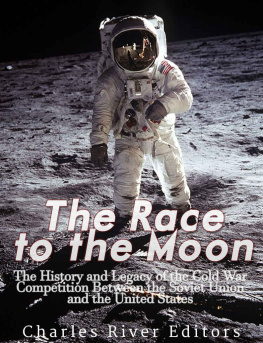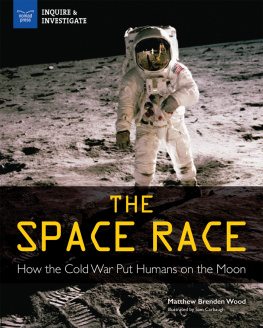Matthew Brzezinski
RED MOON RISING
Sputnik and the Hidden Rivalries that Ignited the Space Age
To Lena,
who wants to be a scientist
and do science stuff
FOR THE FIFTIETH ANNIVERSARY OF SPUTNIK, THE BEHIND-THE-SCENES STORY OF THE FIERCE BATTLES ON EARTH THAT LAUNCHED THE SUPERPOWERS INTO SPACE
THE SPY PLANES WERE DRIVING NIKITA KHRUSHCHEV MAD. Whenever America wanted to peer inside the Soviet Union, it launched a U-2, which flew too high to be shot down. But Sergei Korolev, Russias chief rocket designer, had a solution: an artificial satellite that would orbit the earth and cross American skies at will. On October 4, 1957, the launch of Korolevs satellite, Sputnik, stunned the world.
In Red Moon Rising, Matthew Brzezinski takes us inside the Kremlin, the White House, secret military facilities, deep-cover safe houses, and the halls of Congress to bring to life the Russians and Americans who feared and distrusted their compatriots at least as much as their superpower rivals. Drawing on original interviews and new documentary sources from both sides of the Cold War divide, he shows how Khrushchev and U.S. president Dwight Eisenhower were buffeted by crises of their own creation, leaving the door open to ambitious politicians and scientists to squabble over the heavens and the earth. It is a story rich in the paranoia of the time, and the combatants include two future presidents, survivors of the gulag, corporate chieftains, rehabilitated Nazis, and a general who won the day by refusing to follow orders.
Sputnik set in motion events that led not only to the moon landing but also to cell phones, federally guaranteed student loans, and the wireless Internet. The true story of the birth of the space age has never been told in such dramatic detail, and Red Moon Rising brings it vividly and memorably to life.
September 8, 1944
The rocket rose slowly, tentatively at first, as if reluctant to break from its earthly moorings. Three full seconds elapsed before its tail fins finally cleared the mobile gantry crane that had held it upright.
But now that it was free of its tethers, it seemed to lose self-doubt. Already it felt lighter, stronger. It had consumed nearly 1,000 pounds of propellant to travel those difficult first fifty feet, and the laws of physics were kicking in. Every second from now on meant 275 fewer pounds of spent fuel and oxidizer to carry. Momentum was entering the equation, increasingly on the rockets side. Now it took only a fraction of a second to ascend the next fifty feet; even less to climb the fifty after that.
The worst was over. The heaviest lifting behind, the rocket seemed to settle down; the shaking and shuddering eased, the strain on its structure and systems diminished. It was building off its own forward progress, climbing higher and higher. Beneath it, the clearing in the forest from where it had been launched began to recede from view. Soon the firing sites fuel tankers, transport trailers, sixteen-ton Strabo crane, and armor-plated command-and-control trucks disappeared underneath the canopy of Dutch pines.
The rocket gained speed, rising at 500, 600, and then 700 feet per second. Below, lights from the nearby horse-track oval outside suburban Wassenaar emerged in the evening dusk. Moments later, the glow from the larger city of The Hague filled the panorama. Still, the rocket climbed higher over the Dutch coast, maintaining an exact ninety-degree ascent to prevent its fragile aluminum fuel bladders from bursting. To save weight, they had been designed with a thin skin that could support the rockets 18,948 pounds of propellant only in the vertical position. Any pitch or roll at this stage and the shifting fuel would rupture the holding tanks and explode.
The rocket needed time to lose weight. And so it stayed on its upward course, its trajectory traced by a billowy white vapor trail as its 580- horsepower hydrogen-peroxide steam turbine pumped fuel through 3,184 injection ports into the combustion chamber. There, an electric igniter, a spinning wheel of spark plugs, set fire to the misty mix of ethyl alcohol and liquid oxygen, producing a vein of jet exhaust gases at 4,802 degrees Fahrenheit. That superheated exhaustexiting through a narrow nozzle and sprayed with an alcohol propellant to increase thrustpushed the rocket ever faster. Its rate of ascent was now 1,100 feet per second, its altitude two miles.
Far below, the 117-member firing crew of the second battery of the 485 th Artillery Battalion under the command of SS Gruppenfhrer Hans Kammler suddenly heard a sound like the cracking of a giant whip. They knew without looking up that their rocket had just broken the sound barrier. And it was still accelerating, outrunning its own blast wave.
Twenty-five seconds had elapsed since liftoff. During that period, the rocket had shed six thousand pounds. The temperature of the sheet metal covering parts of its outer skin had spiked from 297 degrees below zero Fahrenheit at the time of fueling to over 300 degrees. The stress on its steel rib cage and interior framing had increased to nearly four times the force of gravity. But most important, its two delicate fuel bladders had drained by more than a third, allowing it to safely begin maneuvering.
At last the rocket was truly free. As if emboldened by its liberation from a strictly upward trajectory, it gained even more speed and altitude as it rolled gracefully on its axis, veered west, and bowed its long, tapered body in a forty-five-degree inclination. Ten miles below, the Dutch coastline retreated from view, giving way to the inky blackness of the North Sea. The rocket was now traveling at twice the speed of sound, still climbing. Vanes in its four tail fins adjusted trim, pitch, and yaw, aided by heat-resistant graphite rudders that directed the flow of its white-hot exhaust gases. The steering mechanisms were in turn guided by a gyroscopic platform fitted beneath the nose cone. This inertial navigation systemthe worlds firstwas the rockets brain, the genius that separated it from all other pretenders. The gimbaled spinning wheels, rotating at 2,000 revolutions per minute, pointed in the same direction no matter where the rocket moved. Accelerometers attached to gimbals read the rockets rotations relative to the rigid platform, telling it exactly where it was heading and what course to steer. But though the rocket had freedom of motion, it did not have free will. Its gyros were preset, its trajectory preordained by a complex set of mathematical equations.
Now, those calculations told it to reduce its trim, to increase its inclination to forty-nine degrees. It did so with the flick of a fin, a tiny twist of the rudder. The new bearing proved an easier angle of ascent, allowing it to go faster still. As thousands more pounds of propellant burned off, the rockets thrust-to-weight ratio, so adverse at liftoff, grew increasingly favorable. Now that its motor was no longer pushing such a heavy load, it could really let loose, plowing forward at 3,335 miles an hour.
Fifteen miles above sea level, the rocket entered the upper layers of the atmosphere, where combustion engines normally suffocate in the thin air. But it breathed easily because it carried its own supply of liquid oxygen. The negative G forces generated by its sustained acceleration now generated eight times the pull of gravity, compressing its nose and ribs. Soon, its skin began to itch from atmospheric friction, heating in places to 500 degrees. But it felt light as a butterfly: it had dropped 17,000 of its original 27,000 pounds and was moving a mile a second.
Sixty-three seconds into its flight, the rocket ceased being a rocket. At an altitude of seventeen miles, the turbine shut down, cutting off fuel to the combustion chamber. Now the rocket was a projectile, a forty-six-foot-long artillery shell painted in a jagged camouflage scheme of signal white, earth gray, and olive green. Although no longer under power, the rocket still rose, moving at 3,500 miles per hour. The laws of physics that had gotten it this far would see it through the final leg of the journey. It broke the twenty-mile and then the thirty-mile barrier, and continued to climb. Another ten seconds passed, and the rocket reached its apogee of fifty-two miles. It was now brushing against the void of outer space.







